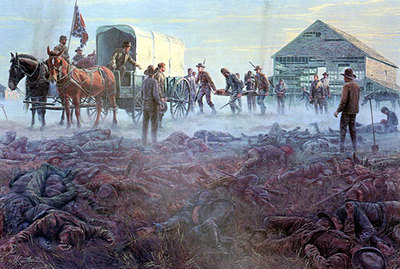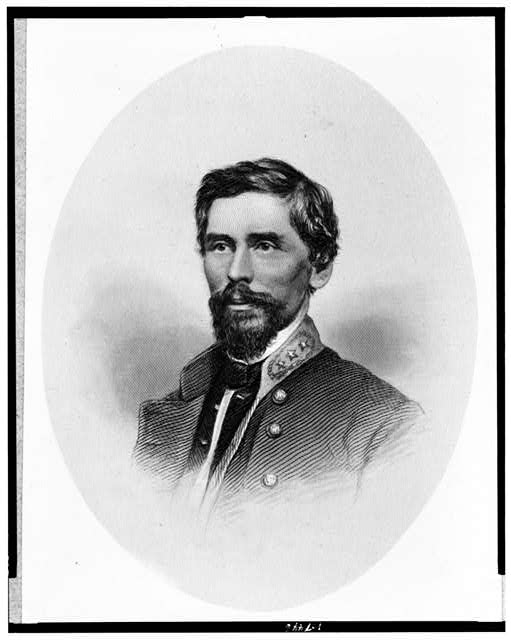“Bringing Cleburne In”
Over the past few months, I’ve been studying the life of Patrick Cleburne. An Irish immigrant to the United States, he settled in Arkansas and sided with the Confederacy during the American Civil War, rising in battlefield success and leadership command in the Western Theater before his death in a charge at the battle of Franklin on November 30, 1864.
Of course, there’s much more to Cleburne’s story and I’m looking forward to sharing more at an upcoming tour this weekend at the American Battlefield Trust’s Annual Conference. (And I’ll probably add a few posts here on ECW over the next few weeks with some interesting accounts I’ve found while researching.) Recently, I asked myself: “What do I remember as first time I heard about or learned something about Patrick Cleburne?”
I think I was about 11 or 12, and I think it was in a book of Mort Kunstler’s art. The piece I recall is titled “Bringing Cleburne In.”

I remember it because I didn’t like it. The twisted bodies of dead soldiers cover half the painting. The subject of the painting — Cleburne — is dead, carried on a stretcher by some of his surviving men, suspended between a hellish scene and the light sky above. Many times I skipped the pages with this painting. But I remember one day I curled myself up in my dad’s easy chair (my “safe reading place” as a child) and made myself look. I’m not sure I could have put the feeling into words, but it was like I needed to make myself acknowledge what happened in battle through art’s lens.
Over the years, I’ve developed a commitment, a standard if you will, to not look away. To not shy away from the reality of war. To look at the hard things. To proverbially (and sometimes literally) look at the dead men in the painting. It’s okay to have a glory story, it’s okay to see how a glory story evolved during real-time and memory. But war is not a glory story, and at some point — and I really do think it’s a point in life, reading, research — we have to decide if we just want the glory story or if we want the real story. They are usually not the same.
So that’s part of my earliest memory of Cleburne. Over the years, I’d picked up history rumors and filed them and read a little more about him. Recently, it’s been rewarding to dig deeper into research about his life. What I’ve really appreciated is that it’s almost impossible to pigeon-hole Cleburne. He doesn’t fit a cookie-cutter mold. And just about the time in his biography that it’s looking “well…typical” he did something that makes typical the wrong word. While I can’t say Cleburne is “my favorite general,” I can say I’ve really enjoyed spending time studying his life and battles.
Yesterday, I was walking near the site of the Carter Cotton Gin in the area of the Union lines where Cleburne died during the battle of Franklin. My brain was rather busy with tour logistics, but I did take some time to pause, ponder, and pay some respect to Cleburne. The title of the Kunstler painting came to mind. What does it mean to be “Bringing Cleburne In”? Sure, it’s obvious in the painting. But what about in the figurative, historic interpretation sense?
It’s been about bringing Cleburne into context of his place and time. That’s where he really stands out. But to see why he stands out, we have to understand what everyone else around him was doing and thinking. He’s a Protestant in Catholic Ireland. He’s an Irishman trying to become an American while Know-Nothingism is sweeping the country and his town’s local politics. He’s a fully-invested Confederate who doesn’t seem to grasp what the Confederate leaders said they were fighting for. He’s a battlefield commander who eventually didn’t get promoted for his success. He’s a romantic who didn’t find love until the last year of his life. He’s still looking for an ultimate battlefield victory when the Confederacy is already crumbling. I’ve gained a greater appreciation for Cleburne’s choices (even the ones I may not agree with) but looking at them against the full context of his era and locations.

Maybe it’s personal, though, too. Maybe for me, it’s about “Bringing Cleburne In” by letting his biography weave itself into the last few months of my research and thoughts. Research opens the opportunity for the lives and deaths of people affect our own lives. Some will only be in a passing way, some will be profoundly life-changing. Cleburne and the painting was long ago tied to my resolve to look at the hard reality. I think it’s still too soon to say what the results of letting Cleburne’s life be part of my recent focus will be, but my “gut feeling” is that it was a much-needed reminder to look at biography against the full context of the era and a good challenge to my brain to be able appreciate the elements and complexities of a person’s life in new and different ways.
Standing in the sloping ground where Cleburne was killed, I felt the threads of research and old memories of a painting weaving together. This will be no glory story, but neither is it a tale of all “doom and gloom.” It is the reality side in the pleasant, the uncomfortable, and the tragic. I felt profoundly lucky by the thought that I get to tell Cleburne’s story. I get to briefly bring Cleburne’s life into historical context, bring his story into words yet again, and bring people to literally walk in his footsteps. I’d like to go back and tell the little kid curled up in the chair staring at the aftermath art: someday, you are going to “bring Cleburne in”…and there will be more to the story than a dead general on a stretcher, both historically and personally.
Thank you for sharing how a particular Civil War painting has influenced you. For me, it was the L. Prang & Co. painting, “Capture of Fort Fisher,” which hung in the barbershop my brother and I visited regularly in the 1960s. The sheer violence depicted in the painting caught my attention and helped fuel a lifelong passion in the Civil War.
Thanks for sharing, Brian. Art really does have a place in capturing interest and imagination.
Contains many of the reasons Cleburne is one of the best (not greatest) leaders in our Civil War.
The title “Bringing Cleburne In” reminded me of a movie a few years ago entitled “Taking Chance”, which was about a Marine Corps officer escorting the body of a young Marine back home for burial. In both the painting and the movie, it is a reflection not just about the decedent, but also about those around him and the impact of his loss on them. Your post is a reflection along with the painting and the movie.
“Taking Chance” is a powerful, powerful movie.
Thanks for mentioning that movie, Bill. I watched it for the first time last year around the time I was researching National Cemeteries. It’s such an impactful film (and probably one of the movies I’ve cried the most over).
Sarah,
One of my favorite generals of the war. “Stonewall of the West” as he is sometimes called.
My confederate ancestors were on that field that day. Luckily they survived.
I look forward to your remarks.
Best regards,
Gilbert Sullivan
I’m glad your ancestors survived that exceptionally awful battle.
I recently gave a talk on Patrick Cleburne and while researching him, I found him to be a fascinating character. He was a plain
and straight-forward man who was not afraid to state his case. His proposal to free the slaves if they fought for the Confederacy
was logically thought out without considering the politics of such a decision. To show the respect that he engendered, a teary eyed
Jefferson Davis was in attendance when Cleburne’s body was taken through Memphis proceeding his re-internment in Helena, Arkansas.
Despite being an Irishman, Cleburne embraced his adopted country as his own and was totally loyal to the state that made him feel welcome.
Nice post. Paintings in the National Geographic history of the war by Robert Paul Jordan left an impression on me. Interestingly many of those have not seen elsewhere. Two really stuck out were Chapman’s self portrait in the Richmond defenses and the sinking of the USS Alabama.
Here are posts I did on each.
https://emergingcivilwar.com/2020/07/16/my-hunt-for-the-c-s-s-alabama/
https://emergingcivilwar.com/2020/08/27/conrad-wise-chapman-and-the-life-insurance-brigade/
Cleburne and five other Confederate generals and thousands of men were uselessly sacrificed by Hood at Franklin. And Hood had to the gall to call into question Cleburne’s manhood when Cleburne and other Confederate generals questioned the wisdom of Hood’s decision to attack. Hood crippled his army at Franklin and then wrecked it at Nashville. He was way over his head as an army commander and thousands of men paid for his ill-advised decisions.
Glad you were able to see the ground in Franklin. Did someone open the door to the Carter farm office for you? I’ve seen that south wall with the light streaming through the bullet holes about a dozen times, and even though I know what I will see, I still pause for a beat…it is incredibly moving.
Yes! A very moving experience to see (in-person) that evidence of battle.
The area around the preserved Franklin buildings is so moving, in part because of Cleburne, and all of the other casualties concentrated in that area.
I look forward to hearing and reading more of your perspective on Gen. Cleburne as you continue your research.
CLEBURNE at Franklin is a great example of how horrid that war was. Keep in mind he was a immigrant from IRELAND. He had been a Sgt in the BRITISH ARMY. He comes to AMERICA, is a success in ARKANSAS, and is one of the most capable officers in the ARMY OF TENNESSEE. All this within a time span of less than 15 years. His objective view of using slaves as soldiers was scorned one spring and implemented the next spring. There is a painting that was released about 30 years ago by a artist named JOHN BLACK called JOURNEYS END. It might be a bit glamoured up but still it shows how tragic those days were. He was the best of the best in the west.